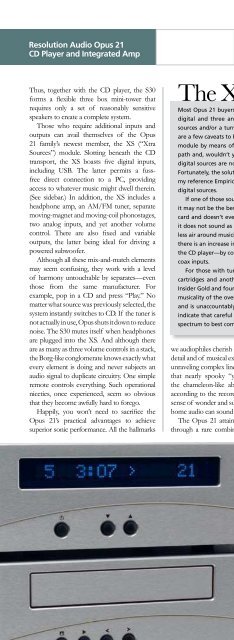You also want an ePaper? Increase the reach of your titles
YUMPU automatically turns print PDFs into web optimized ePapers that Google loves.
Resolution Audio Opus 21<br />
CD Player and Integrated Amp<br />
Thus, together with the CD player, the S30<br />
forms a flexible three box mini-tower that<br />
requires only a set of reasonably sensitive<br />
speakers to create a complete system.<br />
Those who require additional inputs and<br />
outputs can avail themselves of the Opus<br />
21 family’s newest member, the XS (“Xtra<br />
Sources”) module. Slotting beneath the CD<br />
transport, the XS boasts five digital inputs,<br />
including USB. The latter permits a fussfree<br />
direct connection to a PC, providing<br />
access to whatever music might dwell therein.<br />
(See sidebar.) In addition, the XS includes a<br />
headphone amp, an AM/FM tuner, separate<br />
moving-magnet and moving-coil phonostages,<br />
two analog inputs, and yet another volume<br />
control. There are also fixed and variable<br />
outputs, the latter being ideal for driving a<br />
powered subwoofer.<br />
Although all these mix-and-match elements<br />
may seem confusing, they work with a level<br />
of harmony untouchable by separates—even<br />
those from the same manufacturer. For<br />
example, pop in a CD and press “Play.” No<br />
matter what source was previously selected, the<br />
system instantly switches to CD. If the tuner is<br />
not actually in use, Opus shuts it down to reduce<br />
noise. The S30 mutes itself when headphones<br />
are plugged into the XS. And although there<br />
are as many as three volume controls in a stack,<br />
the Borg-like conglomerate knows exactly what<br />
every element is doing and never subjects an<br />
audio signal to duplicate circuitry. One simple<br />
remote controls everything. Such operational<br />
niceties, once experienced, seem so obvious<br />
that they become awfully hard to forego.<br />
Happily, you won’t need to sacrifice the<br />
Opus 21’s practical advantages to achieve<br />
superior sonic performance. All the hallmarks<br />
The XS in Use<br />
Most Opus 21 buyers will not need the XS module. Even without it, the stack allows for two<br />
digital and three analog sources—plenty for most systems. But for those with a wealth of<br />
sources and/or a turntable in need of a phonostage, the XS is just the ticket. However, there<br />
are a few caveats to bear in mind. First, the XS routes its digital traffic to the CD transport/DAC<br />
module by means of a coaxial cable. Unfortunately, that puts the link on the signal’s critical<br />
path and, wouldn’t you know it, the supplied wire is dreadful. With it in place, XS-connected<br />
digital sources are noticeably degraded compared to a direct connection to the DAC module.<br />
Fortunately, the solution is a cable swap away. When I replaced the cheapie supplied cable with<br />
my reference Empirical Design 118 (about $75), the XS could, for the first time, do justice to its<br />
digital sources.<br />
If one of those sources is a PC, another caveat applies. Though there is a USB port on the XS,<br />
it may not be the best sonic choice. The port is certainly easy to use; it bypasses the PC’s sound<br />
card and doesn’t even require a driver. Yet while the port does not embarrass itself sonically,<br />
it does not sound as good as playing the identical bits from the CD. Through the USB, there is<br />
less air around musicians, scale is reduced, the perspective is flatter, rhythms are less sharp, and<br />
there is an increase in grain. I was able to get much better PC-based sound—better, even, than<br />
the CD player—by connecting the sound card’s digital output to one of the XS’s (or CD player’s)<br />
coax inputs.<br />
For those with turntables, the XS incorporates two phonostages—one for moving-magnet<br />
cartridges and another for moving coils. I tested the moving-coil input with my Clearaudio<br />
Insider Gold and found it to have huge dynamics, crisp transients, plenty of depth, and the easy<br />
musicality of the overall stack. On the other hand, the phonostage sounds somewhat closed-in<br />
and is unaccountably recessed in the lower midrange. These aren’t disqualifiers; rather, they<br />
indicate that careful cartridge matching is in order. Choose an mc on the romantic side of the<br />
spectrum to best complement this phonostage. AT<br />
we audiophiles cherish are right here: clarity of<br />
detail and of musical expression; proficiency in<br />
unraveling complex lines and instrumentation;<br />
that nearly spooky “you are there” quality;<br />
the chameleon-like ability to change sound<br />
according to the recording’s dictates; and that<br />
sense of wonder and surprise at just how good<br />
home audio can sound with the right system.<br />
The Opus 21 attains its captivating sonics<br />
through a rare combination of richness and<br />
resolution. All too often, these attributes are at<br />
odds; tonal lushness is usually overwrought and<br />
comes at the expense of timbral complexity<br />
and inner detail. The Opus 21, however,<br />
suffers from none of these ills. It exhibits<br />
only a gentle swell in the lower-midrange,<br />
and its highs are nicely extended, allowing<br />
it to deliver the full spectrum of timbral<br />
overtones. Consequently, both instruments<br />
and vocals sound completely natural. Nor is<br />
inner detail slighted in the least. Apparently,<br />
the manufacturer doesn’t call itself Resolution<br />
Audio for nothing.<br />
By way of illustration, consider two very<br />
different works by budding rock auteur<br />
Sufjan Stevens. On the plaintive, unadorned<br />
“The Dress Looks Nice on You” from<br />
Seven Swans [Sounds Familyre], the Opus<br />
stack conveys not only the acoustic guitar’s<br />
burnished warmth, but also Stevens’ fingers<br />
as they caress and stroke its strings. The<br />
effect is uncannily realistic. This track also<br />
demonstrates that the Opus requires neither a<br />
flailing drum kit nor looped electronica to get<br />
across a beat. Here, the simple guitar figure’s<br />
subtle dynamic accents are sufficient to create<br />
forward motion.<br />
“The Tallest Man, The Broadest Shoulders”<br />
from Illinois [Asthmatic Kitty]—Stevens’<br />
ambitious opus—could not be more different.










